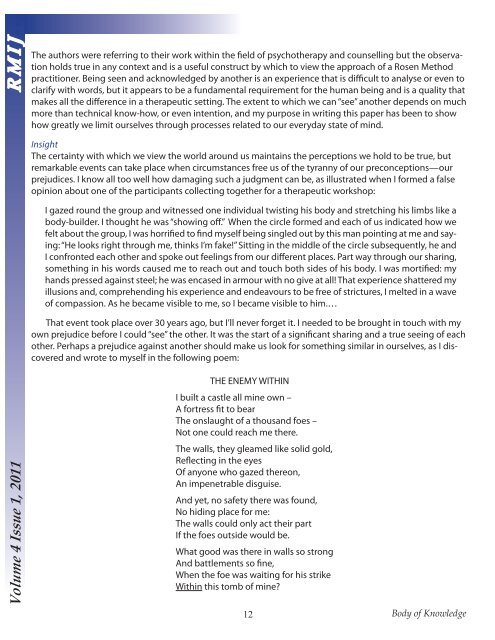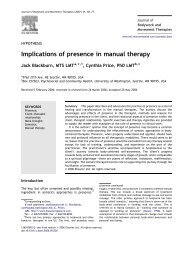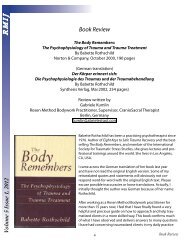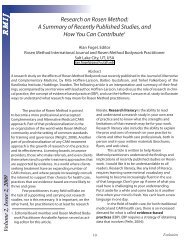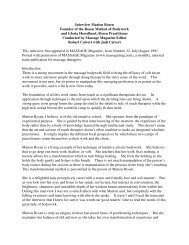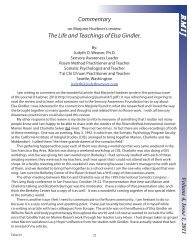R M I J ... Volume 4 Issue 1, 2011 - Rosen Journal
R M I J ... Volume 4 Issue 1, 2011 - Rosen Journal
R M I J ... Volume 4 Issue 1, 2011 - Rosen Journal
Create successful ePaper yourself
Turn your PDF publications into a flip-book with our unique Google optimized e-Paper software.
R M I J . . .<br />
<strong>Volume</strong> 4 <strong>Issue</strong> 1, <strong>2011</strong><br />
The authors were referring to their work within the field of psychotherapy and counselling but the observation<br />
holds true in any context and is a useful construct by which to view the approach of a <strong>Rosen</strong> Method<br />
practitioner. Being seen and acknowledged by another is an experience that is difficult to analyse or even to<br />
clarify with words, but it appears to be a fundamental requirement for the human being and is a quality that<br />
makes all the difference in a therapeutic setting. The extent to which we can “see” another depends on much<br />
more than technical know-how, or even intention, and my purpose in writing this paper has been to show<br />
how greatly we limit ourselves through processes related to our everyday state of mind.<br />
Insight<br />
The certainty with which we view the world around us maintains the perceptions we hold to be true, but<br />
remarkable events can take place when circumstances free us of the tyranny of our preconceptions—our<br />
prejudices. I know all too well how damaging such a judgment can be, as illustrated when I formed a false<br />
opinion about one of the participants collecting together for a therapeutic workshop:<br />
I gazed round the group and witnessed one individual twisting his body and stretching his limbs like a<br />
body-builder. I thought he was “showing off.” When the circle formed and each of us indicated how we<br />
felt about the group, I was horrified to find myself being singled out by this man pointing at me and saying:<br />
“He looks right through me, thinks I’m fake!” Sitting in the middle of the circle subsequently, he and<br />
I confronted each other and spoke out feelings from our different places. Part way through our sharing,<br />
something in his words caused me to reach out and touch both sides of his body. I was mortified: my<br />
hands pressed against steel; he was encased in armour with no give at all! That experience shattered my<br />
illusions and, comprehending his experience and endeavours to be free of strictures, I melted in a wave<br />
of compassion. As he became visible to me, so I became visible to him.…<br />
That event took place over 30 years ago, but I’ll never forget it. I needed to be brought in touch with my<br />
own prejudice before I could “see” the other. It was the start of a significant sharing and a true seeing of each<br />
other. Perhaps a prejudice against another should make us look for something similar in ourselves, as I discovered<br />
and wrote to myself in the following poem:<br />
THE ENEMY WITHIN<br />
I built a castle all mine own –<br />
A fortress fit to bear<br />
The onslaught of a thousand foes –<br />
Not one could reach me there.<br />
The walls, they gleamed like solid gold,<br />
Reflecting in the eyes<br />
Of anyone who gazed thereon,<br />
An impenetrable disguise.<br />
And yet, no safety there was found,<br />
No hiding place for me:<br />
The walls could only act their part<br />
If the foes outside would be.<br />
What good was there in walls so strong<br />
And battlements so fine,<br />
When the foe was waiting for his strike<br />
Within this tomb of mine?<br />
12<br />
Body of Knowledge


